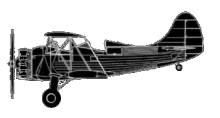
ASN Wikibase Occurrence # 176619
This information is added by users of ASN. Neither ASN nor the Flight Safety Foundation are responsible for the completeness or correctness of this information.
If you feel this information is incomplete or incorrect, you can submit corrected information.
| Date: | Wednesday 3 June 2015 |
| Time: | 07:15 |
| Type: |  Waco UPF-7 |
| Owner/operator: | Upf-7 Llc |
| Registration: | N29943 |
| MSN: | 5441 |
| Year of manufacture: | 1940 |
| Engine model: | Continental W670 SERIES |
| Fatalities: | Fatalities: 0 / Occupants: 1 |
| Aircraft damage: | Substantial |
| Category: | Accident |
| Location: | Cerro Summit, east of Montrose Regional Airport (KMTJ), Montrose, CO -
 United States of America United States of America
|
| Phase: | En route |
| Nature: | Private |
| Departure airport: | Montrose, CO (MTJ) |
| Elbert, CO (CO15) | |
| Investigating agency: | NTSB |
| Confidence Rating: |
The commercial pilot was conducting a cross-country flight in the single-engine vintage airplane. The flight originated from an airport with an elevation of 5,758 ft mean sea level (msl). The pilot reported that the surface wind at the airport was 15 knots at takeoff. He added that the airplane reached an altitude of 8,500 ft msl, which he thought was sufficient to fly over the high, mountainous terrain. However, as the airplane neared higher terrain, it encountered a downdraft. The airplane's climb rate was not sufficient to overcome the effects of the downdraft, and the valley was too narrow to complete a turn to lower ground; the airplane subsequently impacted terrain.
The pilot reported that it would have been safer if he had used better judgment and delayed approaching the higher terrain until he had climbed the airplane to more than 1,000 ft above the ground elevation. Additionally, given the 15-knot surface wind reported at the departure airport, it is likely that the wind aloft at 9,000 ft near the mountain pass where the accident occurred was much stronger. The pilot should have attained an altitude of 2,000 ft or more to ensure that the airplane had sufficient altitude to clear the pass's highest terrain.
Probable Cause: The pilot's failure to attain suitable altitude while flying over high mountainous terrain in downdraft conditions.
Accident investigation:
 |
|
Sources:
NTSB
Location
Revision history:
| Date/time | Contributor | Updates |
|---|---|---|
| 03-Jun-2015 17:37 | Geno | Added |
| 03-Jun-2015 21:20 | Geno | Updated [Aircraft type, Registration, Cn, Operator, Source, Damage, Narrative] |
| 21-Dec-2016 19:30 | ASN Update Bot | Updated [Time, Damage, Category, Investigating agency] |
| 01-Dec-2017 13:43 | ASN Update Bot | Updated [Operator, Other fatalities, Nature, Departure airport, Destination airport, Source, Narrative] |
Corrections or additions? ... Edit this accident description
The Aviation Safety Network is an exclusive service provided by:


 ©2024 Flight Safety Foundation
©2024 Flight Safety Foundation